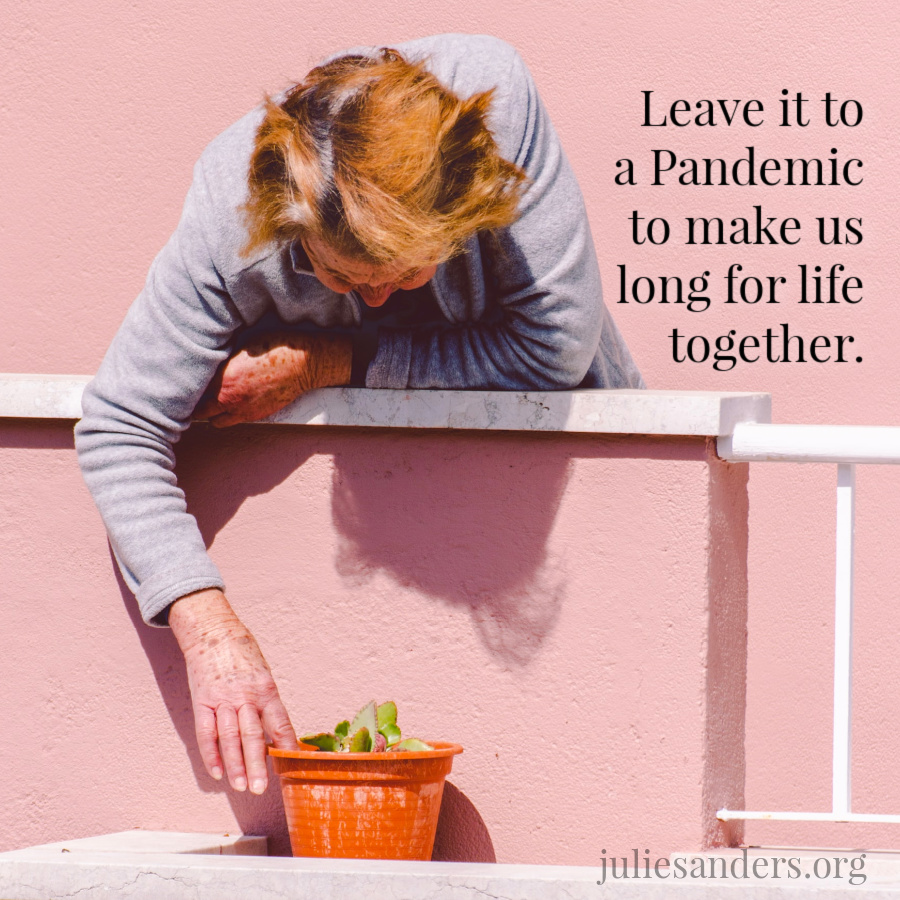Have you been alone a lot this year? Me too. We fondly remember sitting side by side, giving a side hug, sharing a table, or making eye contact – things we took for granted. Oh, forgive us Lord. Slowly, glimpses return and we’re hopeful. A side effect of the Pandemic, isolation leaves us longing to know we aren’t alone.

Professionals working from home, children learning online, college students who vacated dorms, children restricted from playgrounds, young adults sequestered in apartments, worshippers kept from gathering, couples without date nights, new parents in empty maternity wards, ill people gasping in hospital rooms, and grandparents longing for loved ones through windows. Each in our own way, we’ve encountered isolation, and it can be uncomfortable. It’s frightening.
No one wants to COVID alone.
Pandemic restrictions change our interactions. And how about quarantine? The absence of social or relational connection is “social isolation,” and it can lead to loneliness. Being alone in our aloneness doesn’t help with loneliness. When God shaped us, He acknowledged that loneliness is not how we thrive (Genesis 2:18). COVID doesn’t have to doom us to isolation.
Thinking in Isolation
Alone time provides time to think, but being “alone with my thoughts” can be dangerous. It may mean thoughts run unchecked down paths otherwise brought to a healthier place when I’m with healthy people. I may begin to think:
- My situation is worse than it is
- Everyone else is with someone else
- This circumstance will never change
- No one cares about me
- There’s no way to overcome this
- I have so many reasons to be afraid
- God must not love me to let me be here – alone
Functioning in Isolation
Since we’re designed for connection, God wired us to meet these needs. “God sets the lonely in families,” (Psalm 68:6). Reaching out and receiving contact are essential. “Two are better than one,” (Ecclesiastes 4:9-12) when we fall, when we’re vulnerable, when we’re threatened. Leave it to a Pandemic to make us long for life together.
Isolation doesn’t just make us feel bad emotionally; it impacts us physically. This surfaces clearly in research for older adults, but have you observed this in other age groups too? Based on a study conducted before COVID-19 , the Center for Disease Control says one third of adults 45 and older feel lonely, and one in four adults 65 and older are socially isolated. As restrictions grew, isolation grew.
The CDC reports that in addition to anxiety and depression, isolation can be responsible for:
- 29% increase in heart disease
- 32 % increase in stroke
- 50% increase in dementia
The need is so great that organizations like Papa have been founded to fill the gap, arranging “virtual companionship” for older adults. In some cases, people are paying to have a place in another life. Older adults, in particular, need willing relationships to access basic supplies and medication, not to mention the voices, eye contact, and touch of others.
In our own place of isolation, we may not tune in to the isolation of another. We may miss the potential to be the answer to each other’s need. Coronavirus has changed the way we relate, but it hasn’t eliminated the needs, possibilities, or rewards of connecting. Caring for the lonely in COVID is one way we honor God’s design as compassionate mankind.
5 Questions to Ask and Answer Isolation
- Who do you know who is alone and experiencing social isolation?
- Who is in another “category” from you who may long to stop being alone?
- What sources could connect me with the lonely? (church, schools, HOA, etc.)
- How could you use tools to invest time in listening, encouraging, or helping?
- What difference might happen if you intentionally connect with an isolated person?
Download a FREE Printable ISOLATION Worksheet HERE – ISOLATION: A Conversation Guide to Caring. Use this on your own, with a student, or with an others-minded friend.

